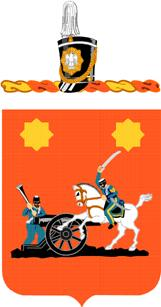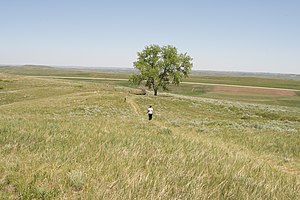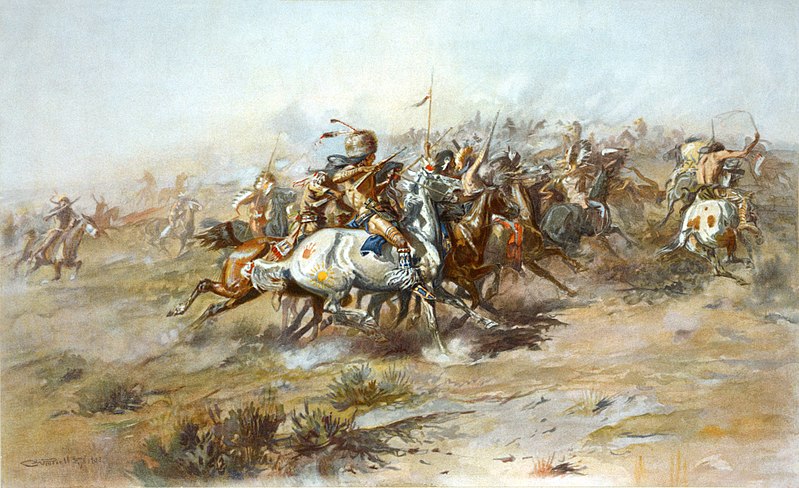 and James Powell arrived at Fort Phil Kearny from the 18th Infantry's headquarters
and James Powell arrived at Fort Phil Kearny from the 18th Infantry's headquarters  garrison at Fort Laramie to replace several officers recently relieved of duty. Unlike Carrington, Fetterman had extensive combat experience during the Civil War. He lacked experience fighting American Indians, however. Fetterman disagreed with Carrington's strategy. Reportedly he said it was "passive" and allegedly boasted that given "80 men," he "would ride through the Sioux nation." Carrington later reported Fetterman's boasts while trying to defend his own reputation.
garrison at Fort Laramie to replace several officers recently relieved of duty. Unlike Carrington, Fetterman had extensive combat experience during the Civil War. He lacked experience fighting American Indians, however. Fetterman disagreed with Carrington's strategy. Reportedly he said it was "passive" and allegedly boasted that given "80 men," he "would ride through the Sioux nation." Carrington later reported Fetterman's boasts while trying to defend his own reputation.
On December 6, Second Lieutenant Horace S. Bingham, commanding Company C, 2nd Cavalry,  was killed by Indians while driving off a force that had attacked a wood train. He had followed them as they retreated over Lodge Trail Ridge
was killed by Indians while driving off a force that had attacked a wood train. He had followed them as they retreated over Lodge Trail Ridge  and been overwhelmed. Carrington worried about his officers' tendency to blindly follow such Indian decoy parties. Fetterman was outraged by what he considered the ineffectiveness of Carrington's leadership. He understood the commander of the Department of the Platte, Gen. Philip St. George Cooke,
and been overwhelmed. Carrington worried about his officers' tendency to blindly follow such Indian decoy parties. Fetterman was outraged by what he considered the ineffectiveness of Carrington's leadership. He understood the commander of the Department of the Platte, Gen. Philip St. George Cooke, to have ordered the garrison to mount an aggressive winter campaignColonel Carrington stated he ordered Fetterman not to cross Lodge Trail Ridge, where relief from the fort would be difficult
to have ordered the garrison to mount an aggressive winter campaignColonel Carrington stated he ordered Fetterman not to cross Lodge Trail Ridge, where relief from the fort would be difficult
 was killed by Indians while driving off a force that had attacked a wood train. He had followed them as they retreated over Lodge Trail Ridge
was killed by Indians while driving off a force that had attacked a wood train. He had followed them as they retreated over Lodge Trail Ridge  and been overwhelmed. Carrington worried about his officers' tendency to blindly follow such Indian decoy parties. Fetterman was outraged by what he considered the ineffectiveness of Carrington's leadership. He understood the commander of the Department of the Platte, Gen. Philip St. George Cooke,
and been overwhelmed. Carrington worried about his officers' tendency to blindly follow such Indian decoy parties. Fetterman was outraged by what he considered the ineffectiveness of Carrington's leadership. He understood the commander of the Department of the Platte, Gen. Philip St. George Cooke, to have ordered the garrison to mount an aggressive winter campaignColonel Carrington stated he ordered Fetterman not to cross Lodge Trail Ridge, where relief from the fort would be difficult
to have ordered the garrison to mount an aggressive winter campaignColonel Carrington stated he ordered Fetterman not to cross Lodge Trail Ridge, where relief from the fort would be difficultFetterman was joined by Captain Frederick Brown, until recently the post quartermaster and another of Carrington's critics. Carrington stated he told Grummond to remind Fetterman of his order not to cross over Lodge Trail Ridge. (The cavalry had to retrieve its mounts before it could follow and catch up with the infantrymen.).jpg) The relief party numbered 79 officers and men. Two civilians, James Wheatley and Isaac Fisher, joined Fetterman, bringing the total force up to 81 men. Instead of marching down the wood road to the relief of the wood train,
The relief party numbered 79 officers and men. Two civilians, James Wheatley and Isaac Fisher, joined Fetterman, bringing the total force up to 81 men. Instead of marching down the wood road to the relief of the wood train,  Fetterman quickly turned north and crossed the Sullivant Hills toward Lodge Trail On the morning of December 21, 1866, the wood train was attacked again. Carrington ordered a relief party, composed of 49 infantrymen of the 18th Infantry, 27 mounted troopers of the 2nd Cavalry and ordred Captain James Powell to command.
Fetterman quickly turned north and crossed the Sullivant Hills toward Lodge Trail On the morning of December 21, 1866, the wood train was attacked again. Carrington ordered a relief party, composed of 49 infantrymen of the 18th Infantry, 27 mounted troopers of the 2nd Cavalry and ordred Captain James Powell to command.  Captain Powell had led a similar effort two days earlier and declined to pursue the Indians over the ridge. However, by claiming seniority as a brevet lieutenant colonel, Fetterman asked for and was given command of the relief party. Powell remained behind. Another officer of the 18th, Lt. George W. Grummond, also a vocal critic of Carrington, led the cavalry. It had been leaderless since Lt. Bingham's death in early December.Within a few minutes of their departure, a Lakota decoy party including Oglala warrior Crazy Horse
Captain Powell had led a similar effort two days earlier and declined to pursue the Indians over the ridge. However, by claiming seniority as a brevet lieutenant colonel, Fetterman asked for and was given command of the relief party. Powell remained behind. Another officer of the 18th, Lt. George W. Grummond, also a vocal critic of Carrington, led the cavalry. It had been leaderless since Lt. Bingham's death in early December.Within a few minutes of their departure, a Lakota decoy party including Oglala warrior Crazy Horse  appeared on Lodge Trail Ridge. Fetterman took the bait, especially since several of the warriors stood on their ponies and insultingly waggled their bare buttocks at the troopers. Fetterman and his company were joined by Grummond at the crossing of
appeared on Lodge Trail Ridge. Fetterman took the bait, especially since several of the warriors stood on their ponies and insultingly waggled their bare buttocks at the troopers. Fetterman and his company were joined by Grummond at the crossing of  the creek, deployed in skirmish line and marched over the Ridge in pursuit. They raced down into the Peno Valley, where an estimated 1,000-3,000 Indians were concealed. They had fought the soldiers there on December 6.
the creek, deployed in skirmish line and marched over the Ridge in pursuit. They raced down into the Peno Valley, where an estimated 1,000-3,000 Indians were concealed. They had fought the soldiers there on December 6.
.jpg) The relief party numbered 79 officers and men. Two civilians, James Wheatley and Isaac Fisher, joined Fetterman, bringing the total force up to 81 men. Instead of marching down the wood road to the relief of the wood train,
The relief party numbered 79 officers and men. Two civilians, James Wheatley and Isaac Fisher, joined Fetterman, bringing the total force up to 81 men. Instead of marching down the wood road to the relief of the wood train,  Fetterman quickly turned north and crossed the Sullivant Hills toward Lodge Trail On the morning of December 21, 1866, the wood train was attacked again. Carrington ordered a relief party, composed of 49 infantrymen of the 18th Infantry, 27 mounted troopers of the 2nd Cavalry and ordred Captain James Powell to command.
Fetterman quickly turned north and crossed the Sullivant Hills toward Lodge Trail On the morning of December 21, 1866, the wood train was attacked again. Carrington ordered a relief party, composed of 49 infantrymen of the 18th Infantry, 27 mounted troopers of the 2nd Cavalry and ordred Captain James Powell to command.  Captain Powell had led a similar effort two days earlier and declined to pursue the Indians over the ridge. However, by claiming seniority as a brevet lieutenant colonel, Fetterman asked for and was given command of the relief party. Powell remained behind. Another officer of the 18th, Lt. George W. Grummond, also a vocal critic of Carrington, led the cavalry. It had been leaderless since Lt. Bingham's death in early December.Within a few minutes of their departure, a Lakota decoy party including Oglala warrior Crazy Horse
Captain Powell had led a similar effort two days earlier and declined to pursue the Indians over the ridge. However, by claiming seniority as a brevet lieutenant colonel, Fetterman asked for and was given command of the relief party. Powell remained behind. Another officer of the 18th, Lt. George W. Grummond, also a vocal critic of Carrington, led the cavalry. It had been leaderless since Lt. Bingham's death in early December.Within a few minutes of their departure, a Lakota decoy party including Oglala warrior Crazy Horse  appeared on Lodge Trail Ridge. Fetterman took the bait, especially since several of the warriors stood on their ponies and insultingly waggled their bare buttocks at the troopers. Fetterman and his company were joined by Grummond at the crossing of
appeared on Lodge Trail Ridge. Fetterman took the bait, especially since several of the warriors stood on their ponies and insultingly waggled their bare buttocks at the troopers. Fetterman and his company were joined by Grummond at the crossing of At approximately noon on that day, men at the fort heard gunfire, beginning with a few shots followed immediately by sustained firing. The ambush was not observed, but evidence indicated the cavalry probably had charged the Indians. The cavalry's most advanced group was nearly a mile down the ridge beyond the infantry. When the Cheyenne and Oglala sprang their trap, the soldiers had no escape. None of them survived.

Reports from the burial party sent to collect the remains said the soldiers had died in three groups. The most advanced and probably most effective were the two civilians, armed with 16-shot Henry repeating rifles, and a small number of cavalrymen who had dismounted and taken cover in the rocks. Up the slope behind them were the bodies of most of the retreating cavalrymen, armed with new 7-shot Spencer carbines,  but encumbered by their horses and without cover. Further up the slope were Fetterman, Brown and the infantrymen, armed with nearly obsolete Civil War muzzle-loading muskets against Indians with equally obsolete weaponry. These foot soldiers fought from cover for a short while, until their ammunition ran out and they were overrun.
but encumbered by their horses and without cover. Further up the slope were Fetterman, Brown and the infantrymen, armed with nearly obsolete Civil War muzzle-loading muskets against Indians with equally obsolete weaponry. These foot soldiers fought from cover for a short while, until their ammunition ran out and they were overrun.
 but encumbered by their horses and without cover. Further up the slope were Fetterman, Brown and the infantrymen, armed with nearly obsolete Civil War muzzle-loading muskets against Indians with equally obsolete weaponry. These foot soldiers fought from cover for a short while, until their ammunition ran out and they were overrun.
but encumbered by their horses and without cover. Further up the slope were Fetterman, Brown and the infantrymen, armed with nearly obsolete Civil War muzzle-loading muskets against Indians with equally obsolete weaponry. These foot soldiers fought from cover for a short while, until their ammunition ran out and they were overrun.
Ten Eyck took a roundabout route and reached the ridgetop just as the firing ceased about 12:45 p.m. He sent back a message reporting that he could not see Fetterman's force, but the valley was filled with groups of Indians taunting him to come down. Ten Eyck suffered severe criticism for not marching straight to the sound of the battle, though doing so would have resulted only in the destruction of his force, too. Ten Eyck reached and recovered the bodies of Fetterman's men. Because of continuing Indian threat, they could not recover those of the cavalry for two days.]Carrington heard the gunfire and immediately sent out a 40-man support force on foot under Captain Tenedor Ten Eyck. Shortly after, the 30 remaining cavalrymen of Company C were sent dismounted to reinforce Ten Eyck, followed by two wagons, the first loaded with hastily loaded ammunition and escorted by another 40 men. Carrington called for an immediate muster of troops to defend the post. Including the wood train detail, the detachments had left only 119 troops remaining inside the fort.

By that time, Fetterman and his entire 81-man detachment were dead. Carrington's official report claimed that Fetterman and Brown shot each other to avoid capture, though Army autopsies recorded Fetterman's death wound as a knife slash. It remains a subject of debate. The warriors mutilated most of the bodies of the soldiers. Most of the dead soldiers were scalped, beheaded, dismembered, disemboweled, and even castrated; facts widely publicized by the newspapers. The only body left untouched was that of a young teenage bugler, Adolph Metzler. He was believed to have fought several Indians with just his bugle as a bludgeon. Aside from his fatal head and chest injuries, his body was left untouched and covered with a buffalo robe by the Indians. The reason for this remains unknown, although it may have been a tribute to his bravery.
This battle was called the "Battle of the Hundred Slain" by the Indians and the "Fetterman Massacre" by the soldiers. It was the Army's worst defeat on the Great Plains  until the disaster on the Little Big Horn nearly ten years later.
until the disaster on the Little Big Horn nearly ten years later.
 until the disaster on the Little Big Horn nearly ten years later.
until the disaster on the Little Big Horn nearly ten years later.
Fort Phil Kearny prepared for a last stand that never came. General Cooke held Carrington solely responsible for the defeat and relieved him of command on December 26, 1866. (While Cooke had planned the relief with the conversion
 of the 2nd Battalion to the 27th Infantry, he ordered it immediately to make the point of rebuke to Carrington.) General Ulysses S. Grant, commanding the U.S. Army, was not inclined to blame only Carrington. He relieved Cooke on
of the 2nd Battalion to the 27th Infantry, he ordered it immediately to make the point of rebuke to Carrington.) General Ulysses S. Grant, commanding the U.S. Army, was not inclined to blame only Carrington. He relieved Cooke on  January 9, 1867.Both an Army court of inquiry and the Secretary of the Interiorconducted investigations of the massacre. The Army's reached no official conclusion, and the Interior's exonerated Carrington. After a severe hip injury, Carrington resigned his commission in 1870. He spent the rest of his life defending his actions and condemning Fetterman's alleged disobedience.
January 9, 1867.Both an Army court of inquiry and the Secretary of the Interiorconducted investigations of the massacre. The Army's reached no official conclusion, and the Interior's exonerated Carrington. After a severe hip injury, Carrington resigned his commission in 1870. He spent the rest of his life defending his actions and condemning Fetterman's alleged disobedience.
The shock of the Fetterman defeat resulted in public calls to reassess the government's Indian policy. Carrington's views came to be the most widely accepted. He placed culpability on reckless actions by Fetterman. On the other hand,  some critics have said that Carrington could have recalled Fetterman before the ambush took place. He could observe from the fort that the attack on the wood train broke off around 11:30.
some critics have said that Carrington could have recalled Fetterman before the ambush took place. He could observe from the fort that the attack on the wood train broke off around 11:30.  Also in mitigation, Fetterman may have believed that he had to support Grummond, even if the cavalry led the advance in
Also in mitigation, Fetterman may have believed that he had to support Grummond, even if the cavalry led the advance in z8-ukgBP!7zoCVL!~~60_3.JPG)
violation of Carrington's orders. Given Grummond's record during the Civil War, he may have been far out in front
violation of Carrington's orders. Given Grummond's record during the Civil War, he may have been far out in front
Historians do not believe Red Cloud took part in the Fetterman battle. He may have been present on August 2, 1867, for the Wagon Box Fight  near Fort Phil Kearny, when a small army detachment used new breech-loading rifles to hold off more than 1,000 Lakota and
near Fort Phil Kearny, when a small army detachment used new breech-loading rifles to hold off more than 1,000 Lakota and uMBPBO,d2qKg~~60_12.JPG) Cheyenne for five hours. The Army had similar success in the Hayfield Fight the previous day.
Cheyenne for five hours. The Army had similar success in the Hayfield Fight the previous day.
 near Fort Phil Kearny, when a small army detachment used new breech-loading rifles to hold off more than 1,000 Lakota and
near Fort Phil Kearny, when a small army detachment used new breech-loading rifles to hold off more than 1,000 Lakota and 
No comments:
Post a Comment